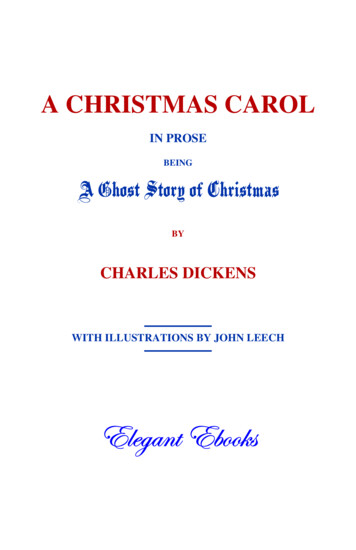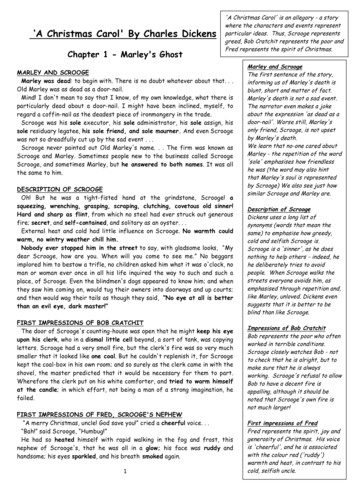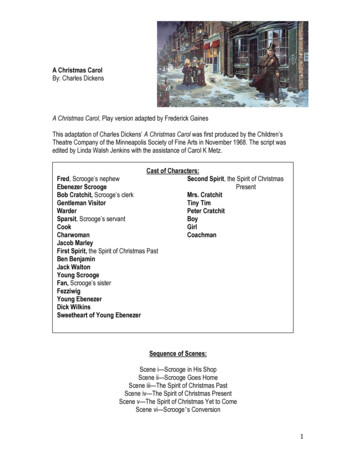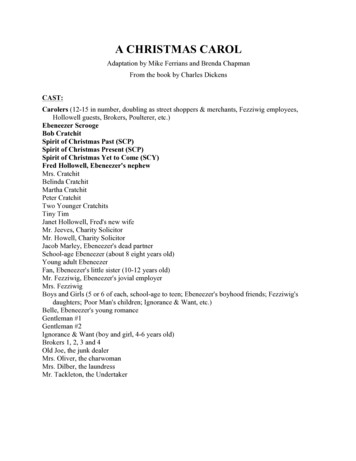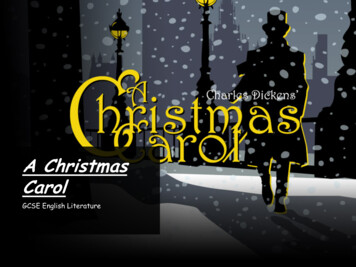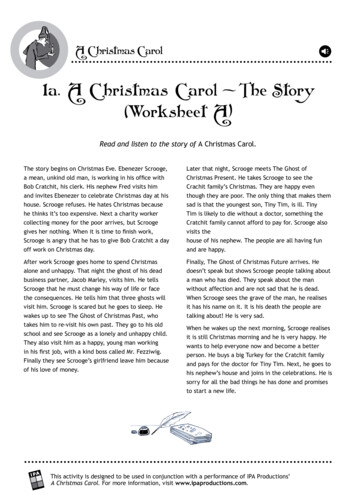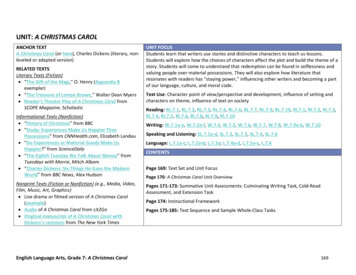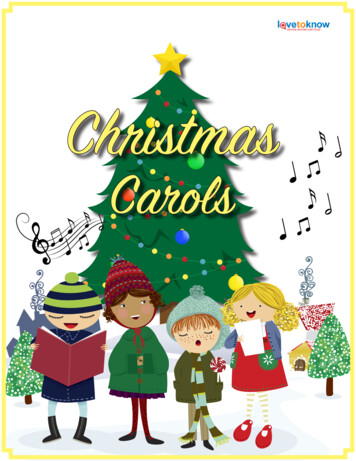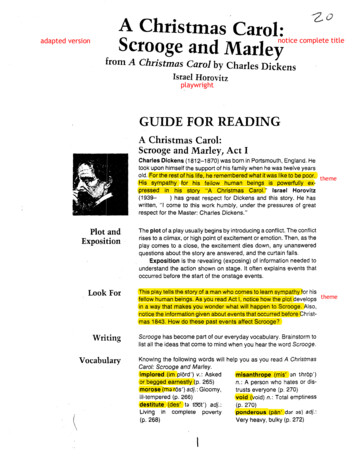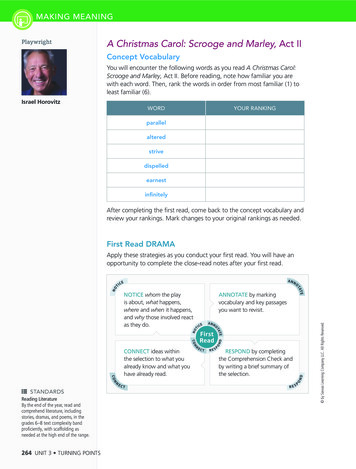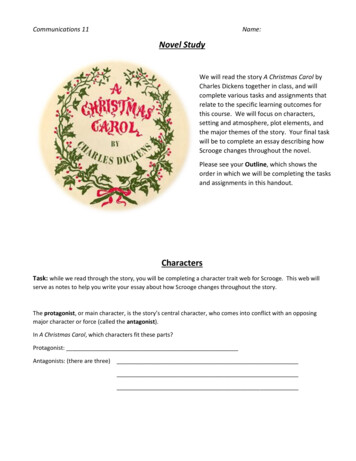
Transcription
A Christmas Carol: Glossary, Commentary and NotesRich BowenChristmas, 2004
Contents1 Introduction62 Stave One : Marley’s Ghost72.1 Terms . . . . . . . . . . . . . . . . . . . . . . . . . . . . . . . . . . . . . . . . . . . . . . . . .72.1.1Stave . . . . . . . . . . . . . . . . . . . . . . . . . . . . . . . . . . . . . . . . . . . . .72.1.2Scrooge . . . . . . . . . . . . . . . . . . . . . . . . . . . . . . . . . . . . . . . . . . . .72.1.3Good upon ’Change . . . . . . . . . . . . . . . . . . . . . . . . . . . . . . . . . . . . .72.1.4Door-nail . . . . . . . . . . . . . . . . . . . . . . . . . . . . . . . . . . . . . . . . . . .82.1.5The wisdom of our ancestors . . . . . . . . . . . . . . . . . . . . . . . . . . . . . . . .82.1.6Assign . . . . . . . . . . . . . . . . . . . . . . . . . . . . . . . . . . . . . . . . . . . . .82.1.7Residuary legatee . . . . . . . . . . . . . . . . . . . . . . . . . . . . . . . . . . . . . . .82.1.8His son’s weak mind . . . . . . . . . . . . . . . . . . . . . . . . . . . . . . . . . . . . .82.1.9Nuts to . . . . . . . . . . . . . . . . . . . . . . . . . . . . . . . . . . . . . . . . . . . .92.1.10 Dog days . . . . . . . . . . . . . . . . . . . . . . . . . . . . . . . . . . . . . . . . . . .92.1.11 Come Down . . . . . . . . . . . . . . . . . . . . . . . . . . . . . . . . . . . . . . . . . .92.1.12 God save you! . . . . . . . . . . . . . . . . . . . . . . . . . . . . . . . . . . . . . . . . .92.1.13 Humbug . . . . . . . . . . . . . . . . . . . . . . . . . . . . . . . . . . . . . . . . . . . .92.1.14 A stake of holly through his heart . . . . . . . . . . . . . . . . . . . . . . . . . . . . .92.1.15 Fellow-passengers . . . . . . . . . . . . . . . . . . . . . . . . . . . . . . . . . . . . . . .92.1.16 Situation . . . . . . . . . . . . . . . . . . . . . . . . . . . . . . . . . . . . . . . . . . .92.1.17 Fifteen shillings . . . . . . . . . . . . . . . . . . . . . . . . . . . . . . . . . . . . . . . .102.1.18 Bedlam . . . . . . . . . . . . . . . . . . . . . . . . . . . . . . . . . . . . . . . . . . . .102.1.19 Are there no prisons? . . . . . . . . . . . . . . . . . . . . . . . . . . . . . . . . . . . .102.1.20 Union workhouses, the Treadmill, and the Poor Law . . . . . . . . . . . . . . . . . . .112.1.21 Surplus population . . . . . . . . . . . . . . . . . . . . . . . . . . . . . . . . . . . . . .112.1.22 The palpable brown air . . . . . . . . . . . . . . . . . . . . . . . . . . . . . . . . . . .112.1.23 Water-plug . . . . . . . . . . . . . . . . . . . . . . . . . . . . . . . . . . . . . . . . . .112.1.24 Saint Dunstan . . . . . . . . . . . . . . . . . . . . . . . . . . . . . . . . . . . . . . . .122.1.25 Half a crown . . . . . . . . . . . . . . . . . . . . . . . . . . . . . . . . . . . . . . . . .12
2.1.26 A bad lobster in a dark cellar . . . . . . . . . . . . . . . . . . . . . . . . . . . . . . . .122.1.27 . through a bad young Act of Parliament . . . . . . . . . . . . . . . . . . . . . . . . .122.1.28 Splinter-bar . . . . . . . . . . . . . . . . . . . . . . . . . . . . . . . . . . . . . . . . . .132.1.29 Dip . . . . . . . . . . . . . . . . . . . . . . . . . . . . . . . . . . . . . . . . . . . . . .132.1.30 Bowels . . . . . . . . . . . . . . . . . . . . . . . . . . . . . . . . . . . . . . . . . . . . .132.1.31 Shade . . . . . . . . . . . . . . . . . . . . . . . . . . . . . . . . . . . . . . . . . . . . .132.1.32 The bandage around its head . . . . . . . . . . . . . . . . . . . . . . . . . . . . . . . .132.1.33 From other regions . . . . . . . . . . . . . . . . . . . . . . . . . . . . . . . . . . . . . .132.2 Notes . . . . . . . . . . . . . . . . . . . . . . . . . . . . . . . . . . . . . . . . . . . . . . . . .133 Stave Two : The First Of The Three Spirits3.1 Terms . . . . . . . . . . . . . . . . . . . . . . . . . . . . . . . . . . . . . . . . . . . . . . . . .15153.1.1United States’ Security . . . . . . . . . . . . . . . . . . . . . . . . . . . . . . . . . . .153.1.2Gigs and carts . . . . . . . . . . . . . . . . . . . . . . . . . . . . . . . . . . . . . . . .153.1.3Plain deal forms . . . . . . . . . . . . . . . . . . . . . . . . . . . . . . . . . . . . . . .163.1.4Valentine and Orson . . . . . . . . . . . . . . . . . . . . . . . . . . . . . . . . . . . . .163.1.5What’s his name? . . . . . . . . . . . . . . . . . . . . . . . . . . . . . . . . . . . . . .173.1.6Postboy . . . . . . . . . . . . . . . . . . . . . . . . . . . . . . . . . . . . . . . . . . . .173.1.7Garden-sweep . . . . . . . . . . . . . . . . . . . . . . . . . . . . . . . . . . . . . . . . .173.1.8Welch wig . . . . . . . . . . . . . . . . . . . . . . . . . . . . . . . . . . . . . . . . . . .173.1.9. hour of seven . . . . . . . . . . . . . . . . . . . . . . . . . . . . . . . . . . . . . . .173.1.10 Organ of benevolence . . . . . . . . . . . . . . . . . . . . . . . . . . . . . . . . . . . .183.1.11 Porter . . . . . . . . . . . . . . . . . . . . . . . . . . . . . . . . . . . . . . . . . . . . .183.1.12 Forfeits . . . . . . . . . . . . . . . . . . . . . . . . . . . . . . . . . . . . . . . . . . . .183.1.13 Negus . . . . . . . . . . . . . . . . . . . . . . . . . . . . . . . . . . . . . . . . . . . . .183.1.14 Sir Roger de Coverley . . . . . . . . . . . . . . . . . . . . . . . . . . . . . . . . . . . .183.1.15 Cut . . . . . . . . . . . . . . . . . . . . . . . . . . . . . . . . . . . . . . . . . . . . . .193.1.16 Beds . under a counter . . . . . . . . . . . . . . . . . . . . . . . . . . . . . . . . . . .193.1.17 Dowerless . . . . . . . . . . . . . . . . . . . . . . . . . . . . . . . . . . . . . . . . . . .193.1.18 the celebrated herd in the poem . . . . . . . . . . . . . . . . . . . . . . . . . . . . . .19
3.2 Notes . . . . . . . . . . . . . . . . . . . . . . . . . . . . . . . . . . . . . . . . . . . . . . . . .4 Stave Three : The Second Of The Three Spirits4.1 Terms . . . . . . . . . . . . . . . . . . . . . . . . . . . . . . . . . . . . . . . . . . . . . . . . .1920204.1.1Free-and-easy . . . . . . . . . . . . . . . . . . . . . . . . . . . . . . . . . . . . . . . . .204.1.2Plume themselves . . . . . . . . . . . . . . . . . . . . . . . . . . . . . . . . . . . . . .204.1.3Acquainted with a move or two . . . . . . . . . . . . . . . . . . . . . . . . . . . . . . .204.1.4Equal to the time-of-day . . . . . . . . . . . . . . . . . . . . . . . . . . . . . . . . . . .204.1.5Pitch and toss . . . . . . . . . . . . . . . . . . . . . . . . . . . . . . . . . . . . . . . .204.1.6Living green . . . . . . . . . . . . . . . . . . . . . . . . . . . . . . . . . . . . . . . . . .204.1.7No sword was in it . . . . . . . . . . . . . . . . . . . . . . . . . . . . . . . . . . . . . .204.1.8Baker’s shops . . . . . . . . . . . . . . . . . . . . . . . . . . . . . . . . . . . . . . . . .204.1.9Norfolk Biffins . . . . . . . . . . . . . . . . . . . . . . . . . . . . . . . . . . . . . . . .204.1.10 Daws . . . . . . . . . . . . . . . . . . . . . . . . . . . . . . . . . . . . . . . . . . . . .214.1.11 Closed on the seventh day . . . . . . . . . . . . . . . . . . . . . . . . . . . . . . . . . .214.1.12 The fashionable Parks . . . . . . . . . . . . . . . . . . . . . . . . . . . . . . . . . . . .214.1.13 Supported by an iron frame . . . . . . . . . . . . . . . . . . . . . . . . . . . . . . . . .224.1.14 Wash-house . . . . . . . . . . . . . . . . . . . . . . . . . . . . . . . . . . . . . . . . . .224.1.15 Twelfth-cakes . . . . . . . . . . . . . . . . . . . . . . . . . . . . . . . . . . . . . . . . .224.1.16 half of half-a-quartern . . . . . . . . . . . . . . . . . . . . . . . . . . . . . . . . . . . .224.1.17 Grog . . . . . . . . . . . . . . . . . . . . . . . . . . . . . . . . . . . . . . . . . . . . . .224.1.18 Tucker . . . . . . . . . . . . . . . . . . . . . . . . . . . . . . . . . . . . . . . . . . . . .234.1.19 Glee . . . . . . . . . . . . . . . . . . . . . . . . . . . . . . . . . . . . . . . . . . . . . .234.1.20 Catch . . . . . . . . . . . . . . . . . . . . . . . . . . . . . . . . . . . . . . . . . . . . .234.1.21 Yes and No . . . . . . . . . . . . . . . . . . . . . . . . . . . . . . . . . . . . . . . . . .234.1.22 Another blindman . . . . . . . . . . . . . . . . . . . . . . . . . . . . . . . . . . . . . .234.1.23 . with all the letters of the alphabet . . . . . . . . . . . . . . . . . . . . . . . . . . .234.1.24 Twelfth Night . . . . . . . . . . . . . . . . . . . . . . . . . . . . . . . . . . . . . . . . .234.2 Notes . . . . . . . . . . . . . . . . . . . . . . . . . . . . . . . . . . . . . . . . . . . . . . . . .244.2.1Dickens and social justice . . . . . . . . . . . . . . . . . . . . . . . . . . . . . . . . . .24
4.2.2The universality of Christmas . . . . . . . . . . . . . . . . . . . . . . . . . . . . . . . .5 Stave Four : The Last Of The Three Spirits5.1 Terms . . . . . . . . . . . . . . . . . . . . . . . . . . . . . . . . . . . . . . . . . . . . . . . . .2425255.1.1Pent-house roof . . . . . . . . . . . . . . . . . . . . . . . . . . . . . . . . . . . . . . . .255.1.2Snuff-box . . . . . . . . . . . . . . . . . . . . . . . . . . . . . . . . . . . . . . . . . . .255.1.3Old Scratch . . . . . . . . . . . . . . . . . . . . . . . . . . . . . . . . . . . . . . . . . .255.1.4Skaiter . . . . . . . . . . . . . . . . . . . . . . . . . . . . . . . . . . . . . . . . . . . . .255.1.5Charwoman . . . . . . . . . . . . . . . . . . . . . . . . . . . . . . . . . . . . . . . . . .255.1.6Money . . . . . . . . . . . . . . . . . . . . . . . . . . . . . . . . . . . . . . . . . . . . .255.1.7He took a child, and set him in the midst of them . . . . . . . . . . . . . . . . . . . .265.1.8The colour? . . . . . . . . . . . . . . . . . . . . . . . . . . . . . . . . . . . . . . . . . .265.2 Notes . . . . . . . . . . . . . . . . . . . . . . . . . . . . . . . . . . . . . . . . . . . . . . . . .265.2.1Silence . . . . . . . . . . . . . . . . . . . . . . . . . . . . . . . . . . . . . . . . . . . . .6 Stave Five : The End Of It6.1 Terms . . . . . . . . . . . . . . . . . . . . . . . . . . . . . . . . . . . . . . . . . . . . . . . . .2627276.1.1Laocoon . . . . . . . . . . . . . . . . . . . . . . . . . . . . . . . . . . . . . . . . . . . .276.1.2Walker . . . . . . . . . . . . . . . . . . . . . . . . . . . . . . . . . . . . . . . . . . . . .276.1.3Joe Miller . . . . . . . . . . . . . . . . . . . . . . . . . . . . . . . . . . . . . . . . . . .276.1.4Sticking-plaister . . . . . . . . . . . . . . . . . . . . . . . . . . . . . . . . . . . . . . .276.1.5Next morning . . . . . . . . . . . . . . . . . . . . . . . . . . . . . . . . . . . . . . . . .276.1.6Waistcoat . . . . . . . . . . . . . . . . . . . . . . . . . . . . . . . . . . . . . . . . . . .276.1.7Strait-waistcoat . . . . . . . . . . . . . . . . . . . . . . . . . . . . . . . . . . . . . . . .276.1.8Smoking Bishop . . . . . . . . . . . . . . . . . . . . . . . . . . . . . . . . . . . . . . .276.1.9Total Abstinence Principle . . . . . . . . . . . . . . . . . . . . . . . . . . . . . . . . .287 Other297.1 Names . . . . . . . . . . . . . . . . . . . . . . . . . . . . . . . . . . . . . . . . . . . . . . . . .297.1.1Ebenezer . . . . . . . . . . . . . . . . . . . . . . . . . . . . . . . . . . . . . . . . . . .297.1.2Scrooge . . . . . . . . . . . . . . . . . . . . . . . . . . . . . . . . . . . . . . . . . . . .29
7.1.3Bob . . . . . . . . . . . . . . . . . . . . . . . . . . . . . . . . . . . . . . . . . . . . . .297.1.4Cratchit . . . . . . . . . . . . . . . . . . . . . . . . . . . . . . . . . . . . . . . . . . . .297.1.5Jacob . . . . . . . . . . . . . . . . . . . . . . . . . . . . . . . . . . . . . . . . . . . . .307.1.6Marley . . . . . . . . . . . . . . . . . . . . . . . . . . . . . . . . . . . . . . . . . . . . .308 Victorian currency30
1IntroductionI have endeavoured in this Ghostly little glossary, to rise the Ghost of understanding of Mr. Dickens’ Ideas,such that my listeners are not put out of humour with the text, with the season, or with myself.Hopefully, with this humble companion to the reading, you may understand why Scrooge’s name was goodupon ’Change, why the fiddler struck up Sir Roger de Coverley, and why the young boy called ScroogeWalker when asked to go buy the prize turkey.Much of the content comes from What Jane Austen Ate and Charles Dickens Knew and from the O.E.D.Other things come from the context of other period literature, from the Dickens Society mailing lists, andfrom reading various commentaries over the years. Much of the simple term definitions came from a varietyof online resources.And, finally, I obtained a huge amount of information from “The Annotated Christmas Carol” by MichaelPatrick Hearn, which is a truly delightful book, the sole failing of which is that it has no index.The year is 1843, and Charles Dickens is struggling on as a serial author for a newspaper. This book is tobe his most popular, and will catapult him to international fame, as well as to enormous financial success.It is this book, more than any other, for which Dickens is remembered. And many credit this book with therevival of the celebration of the Christmas holiday in much of the English-speaking world.In 1678, Josiah King wrote in “The Examination and Tryal of Old Father Christmas” that Father Christmas“of the Town of Superstition, in the Country of Idolatry,” now stood accused of having “from time totime, abused the people of this Common-wealth, drawing and inticing them to Drunkenness, Gluttony, andunlawful Gambling, Wantonness, Uncleanness, Lasciviousness, Cursing, Swearing, abuse of the Creatures,some to one Vice, and some to an other; all to Idleness.” So we see that Scrooge denouncing Christmas asa merely “A poor excuse for picking a man’s pocket ever twenty-fifth of December.”And even Mr. Dickens was criticized for this work by many puritans, because he painted Christmas as atime for merrymaking, and because he mentioned The Demon Liquor just a few too many times in the story.And many devout persons criticized his blasphemy and flippant references to God, sprinkled throughout thetext. With a modern ear, we are hard pressed to hear a single one.In a letter to one offended lady (March 25, 1847) Dickens assures her that if he were at Fecciwig’s ball, “Ishould have taken a little Negus, and possibly not a little beer.” He goes on to remind her “of a certainMarriage in Galilee, and of a certain supper where a cup was filled with Wind and not with water.”
2Stave One : Marley’s GhostStave One, in which we meet Ebenezer Scrooge and Bob Cratchit, and in which the ghost of Jacob Marleyappears to Scrooge to tell him that he may still redeem his life, and avoid an eternity of torment.2.12.1.1TermsStaveArchaic form of “staff”, a stanza of a poem or song. This is an extension of the the title of the book, “AChristmas Carol in Prose.” This pun continues in his other Christmas books, with The Chimes being dividedinto “quarters,” and The Cricket on the Hearth being divided into “chirps.”2.1.2ScroogeScrooge is a money lender whose office is likely located fairly close to the’Change. And he is the most famous miser in literature. Indeed, his namebecame, almost immediately after the publishing of this book, a universalsynonym for miser, and remains so to this day.See 7.1 for more discussion of Scrooge’s name.Scrooge has been played in film by many well-known actors, including PatrickStewart, Rich Little, Michael Caine, Scrooge McDuck, Reginald Owen, Alastair Sim, George C. Scott, and many others.Scrooge is the central character of our story, and so you should get to knowhim well. He is deep, and has had a hard life. This is primarily as a resultof his own decisions, but also has a lot to do with the treatment he receivedfrom his father.Dickens himself appears many times in this story. Much of him comesthrough in the character of Scrooge, although perhaps more of him appearsin Fred.2.1.3Good upon ’ChangeThe ’Change, or the Exchange, was (and is) the equivalent of Wall Street.Financial business in London is conducted on The Strand, and has been for several hundred years. Theoriginal buildings of the Royal Exchange burnt down in 1839, and A Christmas Carol was written in 1843,so the new Exchange would have been completed very recently.A ’change is also, coloquially, a money changer’s office, which is probably why Scrooge is typically picturedas a money lender, in addition to the scene in Stave Four when the young couple is unexpectedly releasedfrom their mortgage by Scrooge’s death.For a man’s name to be good upon ’Change meant that his word was as good as a contract, or as good as abanknote. In other words, if he said it, it was true.
2.1.4Door-nailWilliam Langland, The Vision of Piers Plowman (1362) might bethe origin of the phrase “ded as a dore-nayle.” Or it might dateearlier than that, to an ancient British ballad “St. George forEngland.”But George he did the dragon kill,As dead as any door-nail.And, of course, Shakespeare used the phrase in Henry IV part II,and in Henry VI part II.You will also notice, if you read any abridged version of the book,that this part is left out. When Dickens did public readings ofthis book, he read from his own abridged edition. There are manydifferent versions of this, and one of them is typically used in modern abridged printings, although a handful of publishers have madetheir own abridgements in recent years.2.1.5The wisdom of our ancestorsA sarcastic reference to Edmund Burke’s speech in March of 1775,in which he appealed to the wisdom of our ancestors as being theprimary reason that the American Colonies should remain part of the Empire.In his home at Gad Hill, Dickens had an extensive library of fake books, which was a particular joke ofhis. One series of these books were titled “The Wisdom of Our Ancestors,” with individual volumes titled“Ignorance,” “Superstition,” “The Block,” “The Stake,” “The Rack,” “Dirt,” and “Disease.”2.1.6AssignThe one to whom property will pass upon death.2.1.7Residuary legateeOne to whom the remainder of the estate passes after payment of debts.2.1.8His son’s weak mindIn manuscript, later struck, appears the extended version:. although perhaps you think that Hamlet’s intellexts were strong, I doubt it. If you couldhave such a son tomorrow, depend upon it, you would find him a poser. He would be a mostimpracticable fellow to deal with; and how ever creditable he might be to the family after hisdecease, he would prove a special encumberance in his lifetime, trust me.
2.1.9Nuts to“Nuts to someone” - A source of pleasure or delight to one. Also sometimes “good luck.”2.1.10Dog daysFrom July 3 to August 11, when Sirius, the Dog Star, rises and sets with the sun. The hotest days of theyear.2.1.11Come DownAn expression meaning “to lay down money.” Thus, “come down handsomely” means to be generous withone’s money. they often came down handsomely, and Scrooge never didApparently Dickens was concerned that audiences in the United States would not get this joke, but his fearswere allayed when, at his first public reading in Buffalo (March 13, 1868) “the applause broke forth from allparts of the house.” (Buffalo Commercial Advertiser)2.1.12God save you!Up until 1968, every word spoken on a stage in London had to be approved by the Lord Chamberlain’sexaminer of plays, who determined if it was appropriate. “God save you” was not appropriate, due topossibly being blasphemous. Thus, the phrase “Heaven save you!” was substituted in theatrical renderings.The same was true of the final line, “God bless us every one.”2.1.13HumbugColloquially, a hoax, imposition, fraud, or sham; used interjectionally to mean “stuff and nonsense”; in slang,to deceive or cheat.2.1.14A stake of holly through his heartUp to 1623, it was custom for a murderer or a suicide to be buried with a stake through his heart.2.1.15Fellow-passengersIn his public reading version of this work, after 1867, this phrase is changed to “Fellow-travellers,” a phrasewhich features also in Little Dorrit.2.1.16SituationPost, job, or employment. Also in stave four.
2.1.17Fifteen shillingsFifteen shillings a week actually wasn’t such a bad wage, although it would make things a little tight for aman with six children. Before Dickens started to make money at writing, he was making fifteen shillings aweek. A laborer would generally make eight shillings a week.Cratchit is, in fact, painted in much more dire straits by modern interpretations of the story (television andmovies) than is really warranted by his income.2.1.18BedlamThe Hospital of St. Mary of Bethlehem, founded as a priory in 1247; by 1402, it was a hospital or asylumfor lunatics; by extension, any madhouse; hence, any scene of mad confusion.Asylums were often no more than prisons, where the inmates were subjected to all sorts of horrible tortureswhich were called “treatments.”It also seems that many wealthy people would have inconvenient persons - a spouse, servant, or enemy declared insane and committed to asylyms, where they would be kept in a drugged state, or where theiraccusations would simply be called ravings.2.1.19Are there no prisons?In Chartism, by Thomas Carlyle (1840) we read these sarcastic words:Do we not pass what Acts of Parliament are needful; as many as thirty nine for the shooting of partridgesalone? Are there not treadmills, gibbets; even hospitals, poor-rates, New-Poor Laws? So answers Aristocracy,astonisment in every feature.
2.1.20Union workhouses, the Treadmill, and the Poor LawScrooge suggests that the poor go to the Union workhouses, or to the Treadmill, or that they be taken careof by the Poor Law. I’ll try to summarize what he’s talking about, but it’s long and complicated, so I’mleaving out some of the details.These things can be thought of as the welfare system of the time, although that’s somewhat oversimplifying.The Union Workhouses were workhouses run by the local parish. When you were sent to the workhouse,this was referred to as “going on the parish.” People were sent there if they were poor, or in debt, orotherwise destitute. There they would work for their daily food and lodging. Exactly what they did in theseworkhouses varied from one place to another, but it was always backbreaking menial work.People that had gone on the parish were considered to be the lowest, and even poor people held them incontempt, knowing that they, too, were a week’s wages away from going to the workhouse themselves. A childthat grew up in the workhouse, like Oliver Twist, would often get the disparaging nickname of “Work’us”or “Parish.”The Treadmill, on the other hand, was more of a means of punishment. A criminal would be forced to walkon the treadmill, which consisted of a mechanical device like a moving staircaise. Failure to keep up with themoving stairs could result in serious injury. Nasty things. Ironic that now people voluntarily use treadmills.The Poor Law was something far more convoluted. It was ostensibly to help the poor, but was more effectivein making poverty essentially inescapable.Dickens was a very outspoken opponent of the Poor Law, and both this book and Oliver Twist were anembarassment to the ruling government.2.1.21Surplus populationMr. Filer, a stdent of Malthus appearing in Dickens’ book “The Chimes” puts it this way:“The poor have no eartly right or business to be born. And that we know they haven’t. We reduced it to amathematical certainty long ago!”2.1.22The palpable brown airIn the 1840s, everybody burned coal to head their homes and businesses, and to cook. Coal smoke turns theair brown, and puts a fine layer of black dust on everything. By the time electricity was starting to replacecoal, London was the dirtiest city in the world.2.1.23Water-plugFireplug, or hydrant.
2.1.24Saint DunstanApparently folks at the time would have been familiar with the story of Saint Dunsten. Dunsten was, amongother things, Archbishop of Canturbury in 960. There are a number of interesting legends around him, butone of them says that he was approached by the devil in the disguise of a beautiful woman, and he grabbedher nose with metal-worker’s tongs.Thus, the reference to Saint Dunstan nipping the Evil Spirit’s nose with the cold weather is about thislegend.May 19th is Saint Dunstan’s day. He is the patron saint of goldsmiths.2.1.25Half a crownTwo shillings and sixpence, this was one sixth of Bob’s weekly salary, since he would have worked six daysa week.2.1.26A bad lobster in a dark cellarRotting crayfish, it turns out, emit a phosphorescent glow. This is a reference to Marley’s decaying face.2.1.27. through a bad young Act of ParliamentActs of Parliament were frequently so loosely worded that any determined lawyer would be sure to find aloop hole through which they could get their client to avoid prosecution.
2.1.28Splinter-barThe crossbar in front of a carriage which supports the springs.2.1.29DipA candle made by dipping a wick in melted tallow. Cheaper than a wax candle, which is moulded.2.1.30BowelsMarley had no bowels .The bowels were, to the Victorian, the seat of human emotion. So this is another pun made by Scrooge inan attempt to regain mastery of the situation.2.1.31Shadefor a shade means “for a ghost,” while to a shade means “to a degree.” Scrooge wisely decides not to makea joke.2.1.32The bandage around its headThe dead were usually bound around the chin with a bandage to keep their mouth closed and prevent ghastlyexpressions. This also features in a number of the movie renditions of this scene, with Markey removing thebandage and his jaw falling horribly to his breast.2.1.33From other regionsIt comes from other regions, and is conveyed by other ministersAs a damned soul, Marley cannot speak the name of Christ, nor can he speak of Heaven. This is consistentwith the spirit of Virgil in the fourth canto of Dante’s Inferno.There are many other parallels between Dante’s work and this one. Marley plays Virgil to Scrooge’s Dante.And, as Scrooge would have been sent to the fourth circle of Hell, where he would be forced to roll greatweights, Marley assures him that he will drag great chains for all eternity.Early reviewers made much of these parallels, and there are many others that they noted, but which I willomit. See The Annotated Christmas Carol for more details.2.2NotesUnfortunately, it is the Scrooge of Stave One that remains imprinted on the minds of most people not morefamiliar with the book. The term “Scrooge” has become synonymous with miser, and everyone knows thatEbenezer Scrooge says “Bah! Humbug!” – even those that could not tell you what Humbug means.
I have an idea that, ironically, it is Dickens who is responsible for this work being remembered as dark anddepressing, rather than filled with joy and humor, as it really is.In the 1860’s, particularly after the American Civil War, Dickens toured Europe and the United States,giving public readings of his works. But he was a perfectionist, who felt that he had to read the entire story,rather than just excerpts. So he read a greatly abridged version of A Christmas Carol - his most popularwork - when he did these readings. In doing so, he stripped out most of the light-hearted stuff, leaving justthe bare bones of the story, which is pretty gloomy stuff. Cratchit becomes merely a poor and rather dimwitted clerk, rather than a source of comic relief. Fred becomes the owner of a single rather self-consciousspeech, rather than the selflessly loving nephew. And Fran, God bless her, vanishes entirely. And so, thestory that was imprinted on our culture’s collective memory is a dark and depressing one, redemptive onlyat the last minute in an almost afterthought sort of way.At least, that’s my take on it.Fred is Scrooge’s nephew - the son of his beloved sister Fran, who we will meet in Stave Two.
33.13.1.1Stave Two : The First Of The Three SpiritsTermsUnited States’ SecurityThis one is a little complex. Put simply, it’s a jab at the financial crisis in the USA during the 1840’s, alsocalled the Hungry Forties. During this deep depression, debts were often settled at fifty cents on the dollar,just so that something could be realized on a debt. A United States’ Security, then, was his way of referringto a debt that would never be paid, or one that would be paid at a fraction of its value.3.1.2Gigs and cartsTo a resident of Victorian England, the distinction between a gig, a cart, a carriage, and a dray would havebeen as familar as the difference between a SUV, a minivan, and a station wagon are to you. And, much asthey are now, different varieties of transportation were indications of social standing.Here are the main categories of transportation.A waggon is a large heavy vehicle used primarily for carrying goods. Draw by perhaps as many as 10 hourses,and travelling at about 4 or 5 miles per hour. A van is smaller and somewhat faster. Waggons and vans areusually open vehicles.A coach is an enclosed four-wheel vehicle. In the late 1700s, a coach might even have springs, which madethe ride more pleasant. The mail coach carried the mail, while a stage coach would carry passengers. Astage was a portion of the journey. At each stage, the coach would change horses.A carriage is a more noble vehicle. You had arrived in the social elite when you could afford your owncarriage. There were various different styles of carriage, including barouches, landaus, victorias, curricles,and broughams, depending on body style, the number of horses, how many passengers they carried, and thenumber of wheels.
A gig is a two-wheeled carriage, drawn by one horse, and carrying one or two persons. A stanhope and atilbury are two styles of gigs. A curricle, on the other hand, is like a gig, but for two horses. Only therich would have a curricle, as the horses were supposed to be perfectly matched, making it an expensiveproposition to equip a curricle properly. Think of it as a rich young man’s sports car. When Dickens startedmaking money at writing, the first thing he bought was a
Christmas Carolin Prose." This pun continues in his other Christmas books, with The Chimes being divided into \quarters," and The Cricket on the Hearth being divided into \chirps." 2.1.2 Scrooge Scrooge is a money lender whose o ce is likely located fairly close to the ’Change. And he
